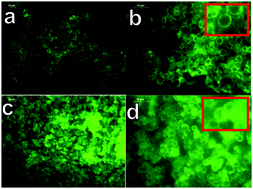Hybrid inhalable microparticles for dual controlled release of levofloxacin and DNase: physicochemical characterization and in vivo targeted delivery to the lungs†
Abstract
Current medical treatments against recurrent pulmonary infections caused by Pseudomonas aeruginosa, such as cystic fibrosis (CF) disorder, involve the administration of inhalable antibiotics. The main challenge is, however, the eradication of microbial biofilms immersed in dense mucus that requires high and recurrent antibiotic doses. Accordingly, the development of novel drug delivery systems capable of providing local and controlled drug release in the lungs is a key factor to improve the therapeutic outcome of such therapeutic molecules. Inhalable hybrid carriers were prepared by co-precipitation of CaCO3 in the presence of alginate and the resulting microparticles were treated with alginate lyase (AL) in order to modify their porosity and enhance the drug loading. The hybrid microparticles were loaded with DNase (mucolytic agent) and levofloxacin (LV, wide-spectrum antibiotic) in the range of 20–40% for LV and 28–67% for DNase, depending on the AL treatment. In vitro studies demonstrated that microparticles were able to control the DNase release for 24 h, while 30–50% of LV was released in 3 days. The morphological characterization was performed by optical, fluorescence and scanning electron microscopies, showing a narrow size distribution (5 μm). FTIR, XRD, DSC and nitrogen adsorption isotherm studies revealed the presence of the drugs in a non-crystalline state. A microcidal effect of microparticles was found on P. aeruginosa in agar plates and corroborated by Live/Dead kit and TEM observations. Finally, to study whether the microparticles improved the localization of LV in the lungs, in vivo studies were performed by pulmonary administration of microparticles to healthy mice via nebulization and dry powder inhalation, followed by the quantification of LV in lung tissue. The results showed that microparticles loaded with LV delivered the antibiotic at least 3 times more efficiently than free LV. The developed system opens the gateway to new drug delivery systems that may provide enhanced therapeutic solutions against bacterial infections and in particular as a potential tool in CF pathology.

- This article is part of the themed collection: 2017 Journal of Materials Chemistry B HOT Papers


 Please wait while we load your content...
Please wait while we load your content...